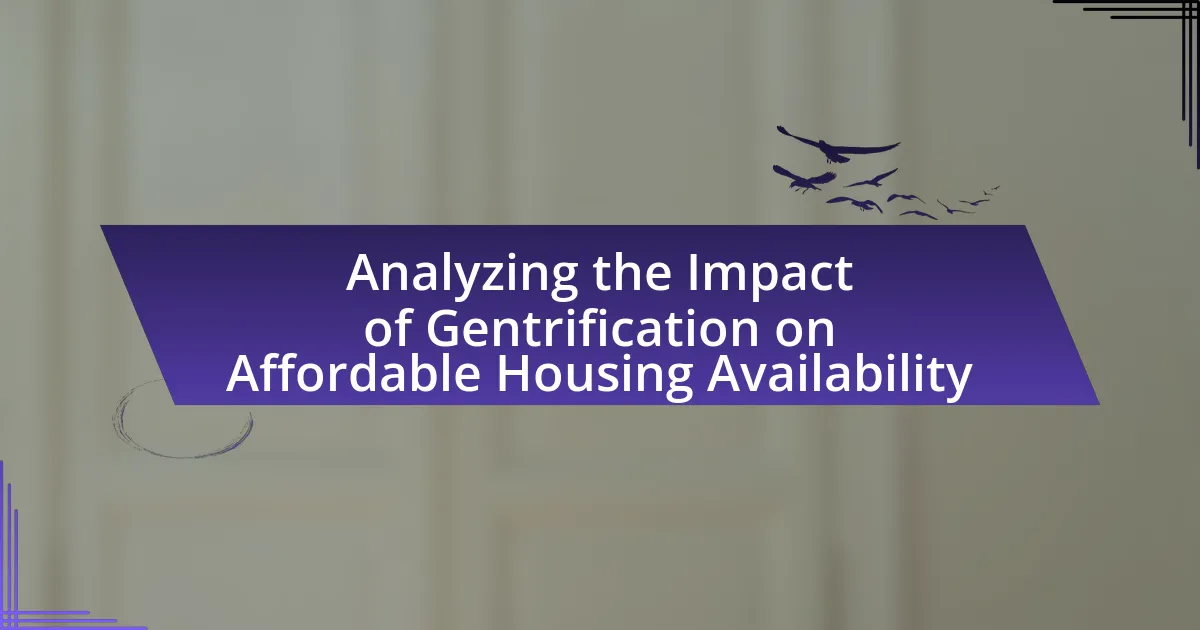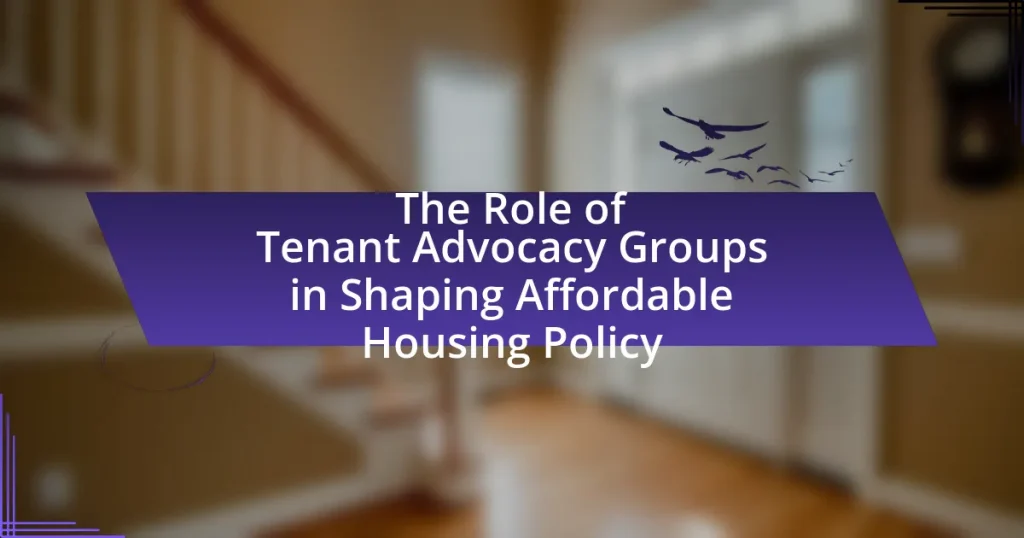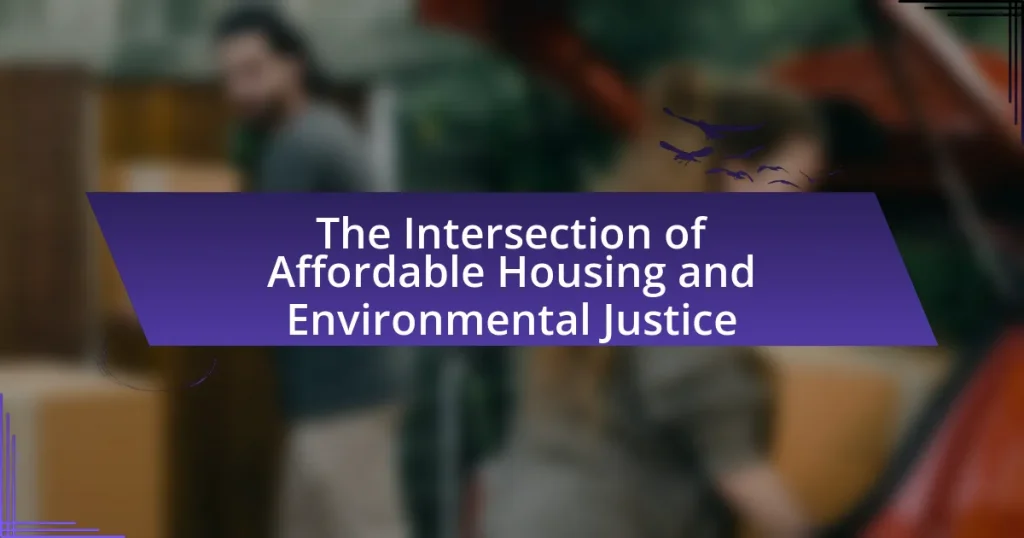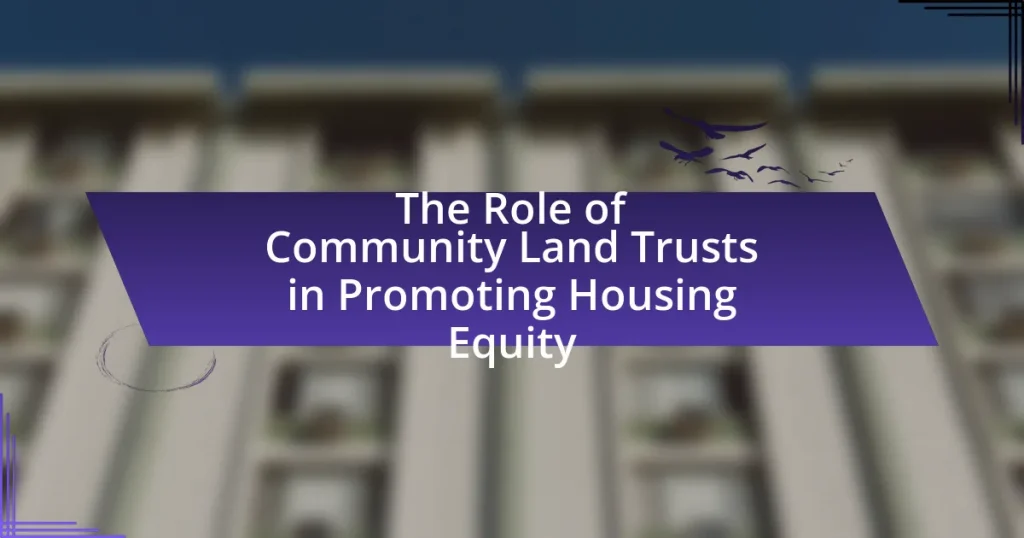Gentrification is the urban transformation process where wealthier individuals move into lower-income neighborhoods, resulting in increased property values and living costs, which negatively impacts affordable housing availability. This article analyzes the characteristics of gentrification, its effects on neighborhood demographics, and the economic factors driving this phenomenon. It highlights the importance of affordable housing in urban areas, the social implications of its shortages, and the potential policies that can mitigate gentrification’s adverse effects. Additionally, the article discusses community responses to gentrification and the long-term consequences on housing markets, providing insights into successful case studies and practical steps for preserving affordable housing amidst rising costs.
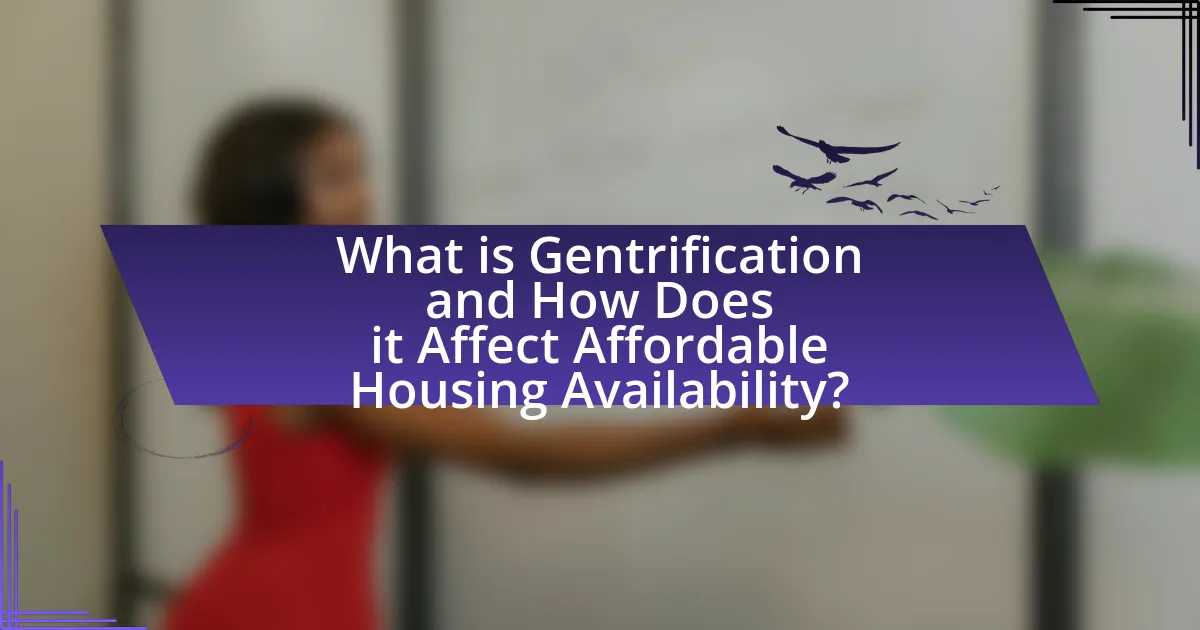
What is Gentrification and How Does it Affect Affordable Housing Availability?
Gentrification is the process of urban transformation where wealthier individuals move into a previously lower-income neighborhood, leading to increased property values and living costs. This phenomenon negatively affects affordable housing availability by displacing long-term residents who can no longer afford rising rents and property taxes. For instance, a study by the National Community Reinvestment Coalition found that gentrification can lead to a 30% increase in rental prices, significantly reducing the stock of affordable housing in affected areas.
What are the key characteristics of gentrification?
The key characteristics of gentrification include the influx of higher-income residents into previously lower-income neighborhoods, leading to increased property values and rents. This process often results in the displacement of long-term residents who can no longer afford to live in the area. Additionally, gentrification is marked by the renovation of housing and commercial properties, the introduction of new businesses catering to wealthier clientele, and changes in the cultural landscape of the neighborhood. Studies, such as those conducted by the Urban Institute, show that gentrification can significantly reduce the availability of affordable housing, as seen in cities like San Francisco and New York, where low-income residents face rising costs and limited housing options.
How does gentrification change neighborhood demographics?
Gentrification changes neighborhood demographics by increasing the proportion of higher-income residents while displacing lower-income populations. This process often leads to a shift in the socioeconomic status of the area, as new developments attract wealthier individuals and families, resulting in rising property values and rents. For instance, a study by the Federal Reserve Bank of Philadelphia found that neighborhoods experiencing gentrification saw a significant increase in median household income, while the percentage of low-income residents decreased. This demographic shift can alter the cultural landscape and community dynamics, as long-standing residents may be forced to relocate due to affordability issues.
What economic factors drive gentrification?
Economic factors driving gentrification include rising property values, increased investment in urban areas, and the influx of higher-income residents. These factors lead to a transformation of neighborhoods as developers seek to capitalize on the demand for housing and commercial spaces. For instance, a study by the Federal Reserve Bank of Philadelphia found that neighborhoods experiencing gentrification often see a significant increase in property prices, which can rise by as much as 30% within a few years. Additionally, the availability of jobs and amenities in urban centers attracts wealthier individuals, further displacing lower-income residents and altering the socio-economic landscape.
Why is affordable housing important in urban areas?
Affordable housing is crucial in urban areas because it ensures that low- and moderate-income families have access to safe and stable living conditions. Urban centers often experience high demand for housing, leading to increased rents and displacement of vulnerable populations. According to the National Low Income Housing Coalition, in 2021, there was a shortage of 7 million affordable rental homes for extremely low-income renters in the United States. This shortage exacerbates issues such as homelessness, economic inequality, and social instability, making affordable housing a vital component of urban planning and community development.
What are the social implications of affordable housing shortages?
Affordable housing shortages lead to increased homelessness, social instability, and economic disparity. When affordable housing is scarce, low-income families often face eviction or are forced to relocate to less desirable areas, which can disrupt community ties and increase social isolation. According to the National Low Income Housing Coalition, in 2021, there were only 37 affordable and available rental homes for every 100 extremely low-income renter households, highlighting the severe mismatch between housing supply and demand. This shortage exacerbates issues such as crime rates, mental health problems, and educational disparities, as families struggle to secure stable living conditions.
How does affordable housing contribute to community stability?
Affordable housing contributes to community stability by providing residents with secure and affordable living options, which fosters long-term residency and community engagement. When individuals and families can afford to live in a neighborhood without the threat of displacement, they are more likely to invest in their homes and participate in local activities, leading to stronger social ties and community cohesion. Research indicates that stable housing reduces turnover rates, which enhances neighborhood safety and promotes local economic development. For instance, a study by the Urban Institute found that neighborhoods with higher rates of affordable housing have lower rates of crime and increased community involvement, demonstrating the direct correlation between affordable housing and community stability.
What are the potential impacts of gentrification on affordable housing?
Gentrification significantly reduces the availability of affordable housing. As wealthier individuals move into previously lower-income neighborhoods, property values and rents increase, often displacing long-term residents who can no longer afford to live there. A study by the National Community Reinvestment Coalition found that gentrification can lead to a 30% increase in rents, which exacerbates housing insecurity for lower-income families. Additionally, the conversion of rental units into higher-end condominiums further diminishes the stock of affordable housing, making it increasingly difficult for low-income individuals to find suitable living arrangements.
How does gentrification lead to displacement of low-income residents?
Gentrification leads to the displacement of low-income residents primarily through rising property values and increased living costs. As neighborhoods undergo gentrification, investments in infrastructure and amenities attract higher-income individuals, which drives up rents and property taxes. For instance, a study by the Federal Reserve Bank of Philadelphia found that gentrification can increase rents by as much as 30% in affected areas. Consequently, long-term low-income residents often find themselves unable to afford their homes, leading to forced relocation. This process is exacerbated by the lack of affordable housing options, as new developments typically cater to wealthier residents, further marginalizing those with lower incomes.
What changes occur in housing prices due to gentrification?
Gentrification leads to an increase in housing prices as wealthier individuals move into previously lower-income neighborhoods. This influx of higher-income residents drives demand for housing, resulting in rising property values and rental rates. For example, a study by the National Community Reinvestment Coalition found that neighborhoods experiencing gentrification saw home prices increase by an average of 30% over a decade, significantly outpacing the national average. Consequently, long-term residents often face displacement due to unaffordable housing costs, further illustrating the impact of gentrification on housing prices.

How Does Gentrification Influence Policy and Community Response?
Gentrification influences policy and community response by prompting local governments to implement zoning changes and affordable housing initiatives. As neighborhoods undergo gentrification, rising property values and rents often lead to displacement of long-term residents, which in turn pressures policymakers to address housing affordability. For instance, cities like San Francisco have enacted inclusionary zoning laws requiring developers to allocate a percentage of new housing units as affordable, aiming to mitigate the negative impacts of gentrification. Additionally, community organizations often mobilize to advocate for tenant protections and affordable housing projects, reflecting a grassroots response to the challenges posed by gentrification. This dynamic interplay between policy adjustments and community activism illustrates how gentrification shapes both governmental strategies and local responses to housing issues.
What policies can mitigate the negative effects of gentrification?
Policies that can mitigate the negative effects of gentrification include rent control, inclusionary zoning, and community land trusts. Rent control stabilizes housing costs for existing residents, preventing displacement due to rising rents. Inclusionary zoning mandates that a percentage of new developments be affordable for low- and moderate-income households, ensuring that new housing stock remains accessible. Community land trusts allow communities to collectively own land, which helps maintain affordability and prevents speculative price increases. These policies have been shown to effectively preserve affordable housing options in gentrifying neighborhoods, as evidenced by case studies in cities like San Francisco and New York, where such measures have been implemented to counteract displacement.
How do inclusionary zoning laws affect affordable housing availability?
Inclusionary zoning laws increase affordable housing availability by requiring developers to include a percentage of affordable units in new residential projects. These laws aim to create mixed-income communities and counteract the effects of gentrification, which often displaces low-income residents. For instance, a study by the Urban Institute found that cities with inclusionary zoning policies saw a 15% increase in affordable housing units compared to those without such regulations. This demonstrates that inclusionary zoning can effectively enhance the stock of affordable housing in areas experiencing rising property values.
What role do community land trusts play in preserving affordable housing?
Community land trusts (CLTs) play a crucial role in preserving affordable housing by removing land from the speculative real estate market and ensuring long-term affordability for residents. CLTs achieve this by acquiring land and holding it in trust, allowing them to control the use and development of the property while providing affordable housing options to low- and moderate-income families. For instance, a study by the Lincoln Institute of Land Policy found that CLTs can maintain affordability for homes by limiting resale prices and providing shared equity models, which help prevent displacement due to gentrification. This model has been effective in various cities, demonstrating that CLTs can stabilize neighborhoods and provide sustainable housing solutions amidst rising property values.
How do communities respond to gentrification?
Communities respond to gentrification through various strategies, including organizing protests, advocating for policy changes, and forming coalitions to protect affordable housing. For instance, residents often mobilize to resist displacement by demanding rent control measures or increased funding for affordable housing initiatives. Research indicates that neighborhoods experiencing gentrification frequently see the emergence of community groups focused on preserving local culture and preventing the loss of long-standing residents. A study by the Urban Institute highlights that in cities like San Francisco and New York, grassroots movements have successfully influenced local government policies to prioritize affordable housing development amidst rising property values.
What strategies do residents use to resist displacement?
Residents use various strategies to resist displacement, including forming tenant unions, engaging in community organizing, and advocating for policy changes. Tenant unions empower residents to collectively negotiate with landlords and protect their rights, while community organizing fosters solidarity and mobilizes residents to oppose gentrification efforts. Additionally, advocacy for policies such as rent control and affordable housing initiatives can create legal protections against displacement. These strategies have been documented in studies showing that organized resistance can lead to successful outcomes in maintaining affordable housing and preventing displacement in gentrifying neighborhoods.
How can community engagement shape housing policies?
Community engagement can significantly shape housing policies by ensuring that the voices and needs of residents are incorporated into decision-making processes. When local communities actively participate in discussions about housing, they can influence policy outcomes that reflect their specific needs, such as the preservation of affordable housing and the prevention of displacement due to gentrification. For instance, studies have shown that cities with strong community engagement frameworks, like Portland, Oregon, have successfully implemented policies that prioritize affordable housing development and tenant protections, demonstrating the effectiveness of resident input in shaping equitable housing policies.
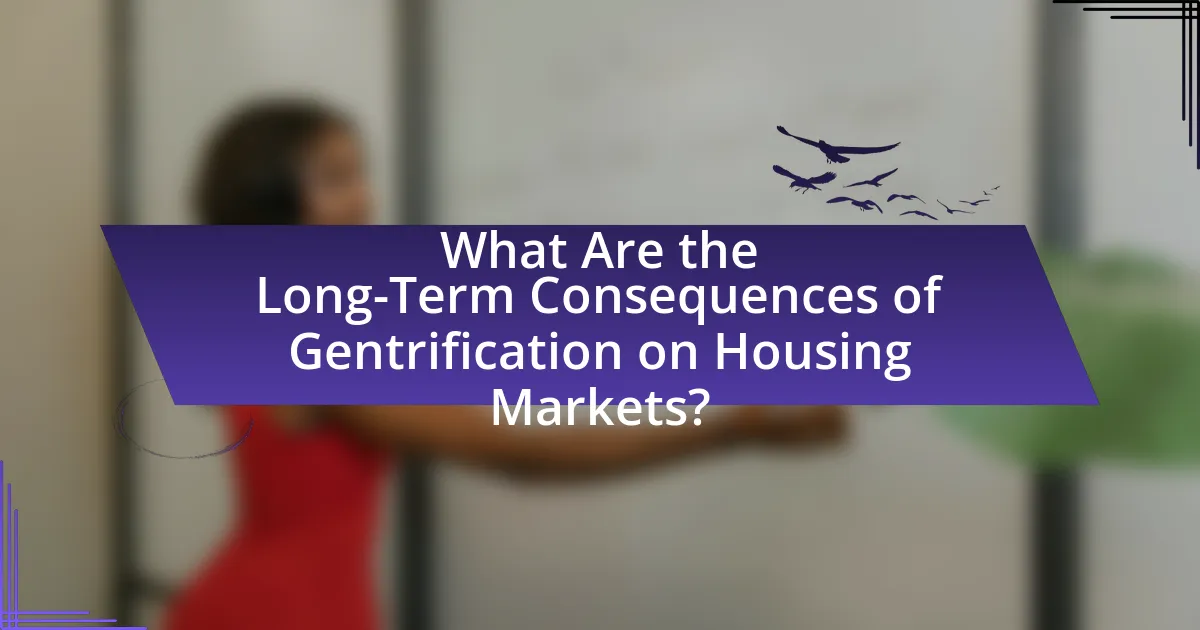
What Are the Long-Term Consequences of Gentrification on Housing Markets?
The long-term consequences of gentrification on housing markets include increased property values and rents, which often displace lower-income residents. As neighborhoods undergo gentrification, the influx of higher-income individuals leads to a demand for upscale housing and amenities, driving up prices. For example, a study by the National Community Reinvestment Coalition found that gentrifying neighborhoods in cities like Washington, D.C., experienced a 30% increase in housing costs over a decade, significantly affecting affordability for existing residents. This displacement can result in a loss of cultural diversity and community cohesion, as long-term residents are forced to relocate to more affordable areas.
How does gentrification affect the overall housing market dynamics?
Gentrification significantly alters overall housing market dynamics by increasing property values and rental prices in previously lower-income neighborhoods. This process often leads to the displacement of long-term residents who can no longer afford the rising costs, thereby changing the demographic and socioeconomic landscape of the area. For instance, a study by the National Community Reinvestment Coalition found that neighborhoods experiencing gentrification saw property values increase by an average of 30% over a decade, which directly correlates with higher rents and reduced affordable housing stock. Consequently, while gentrification can lead to improved infrastructure and amenities, it simultaneously exacerbates housing affordability issues for existing residents.
What trends emerge in housing development post-gentrification?
Post-gentrification, housing development trends often include an increase in luxury housing and a decrease in affordable units. This shift occurs as developers target higher-income residents, leading to the construction of upscale apartments and condominiums. For instance, a study by the Urban Institute found that in neighborhoods experiencing gentrification, the proportion of new housing units classified as affordable dropped significantly, with many areas seeing a rise in market-rate developments. Additionally, there is often a trend toward mixed-use developments that cater to affluent demographics, further exacerbating the scarcity of affordable housing options for lower-income residents.
How does gentrification impact rental markets in urban areas?
Gentrification significantly increases rental prices in urban areas, often displacing lower-income residents. As wealthier individuals move into previously affordable neighborhoods, demand for housing rises, leading to higher rents. For instance, a study by the National Community Reinvestment Coalition found that neighborhoods experiencing gentrification saw rental prices increase by an average of 30% over a decade, while wages for existing residents did not keep pace. This disparity exacerbates housing insecurity and reduces the availability of affordable housing options for long-term residents.
What lessons can be learned from cities that have experienced gentrification?
Cities that have experienced gentrification demonstrate the importance of implementing policies that protect affordable housing. For instance, in cities like San Francisco, the rapid increase in property values led to significant displacement of low-income residents, highlighting the need for rent control measures and inclusionary zoning policies to maintain affordable housing stock. Additionally, lessons from New York City reveal that community engagement in urban planning can mitigate negative impacts, as involving residents in decision-making processes fosters equitable development. These examples underscore the necessity of proactive strategies to balance urban revitalization with the preservation of affordable housing options.
What successful case studies exist for maintaining affordable housing during gentrification?
Successful case studies for maintaining affordable housing during gentrification include the East Lake Community in Atlanta, Georgia, and the 11th Street Bridge Park project in Washington, D.C. The East Lake Community transformed a distressed neighborhood into a mixed-income community by implementing a comprehensive redevelopment strategy that included affordable housing, community services, and economic opportunities. This initiative resulted in a 90% reduction in crime and increased property values while preserving affordable housing options. Similarly, the 11th Street Bridge Park project aims to create a public space that connects neighborhoods while incorporating affordable housing and community resources, ensuring that long-term residents are not displaced. Both case studies demonstrate effective strategies for balancing development and affordability amidst gentrification pressures.
How can other cities apply these lessons to their housing policies?
Other cities can apply lessons from analyzing the impact of gentrification on affordable housing availability by implementing policies that prioritize the preservation of existing affordable housing stock and promote inclusive development. For instance, cities can adopt rent control measures and inclusionary zoning policies that require developers to allocate a percentage of new units for low-income residents. Evidence from cities like San Francisco shows that such policies can mitigate displacement and maintain diversity in neighborhoods. Additionally, cities can invest in community land trusts, which have been effective in stabilizing housing costs and ensuring long-term affordability, as demonstrated by successful models in Burlington, Vermont. By integrating these strategies, cities can create more equitable housing policies that address the challenges posed by gentrification.
What practical steps can communities take to address gentrification’s impact on affordable housing?
Communities can implement inclusionary zoning policies to ensure that a percentage of new housing developments are designated as affordable. This approach has been adopted in cities like San Francisco, where such policies have resulted in the creation of thousands of affordable units. Additionally, communities can establish land trusts to acquire and maintain properties for affordable housing, as seen in Burlington, Vermont, where the community land trust model has successfully preserved affordability over time. Furthermore, local governments can provide financial incentives for developers to create affordable housing, which has been effective in places like New York City, where tax abatements have encouraged the construction of lower-income units. These practical steps can mitigate the adverse effects of gentrification on affordable housing availability.
